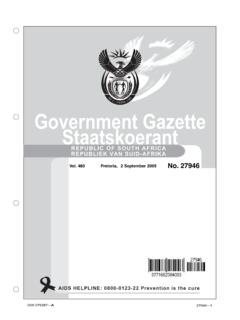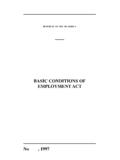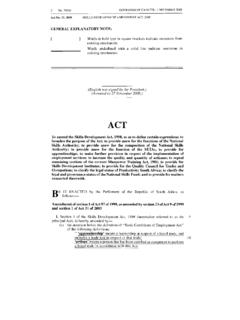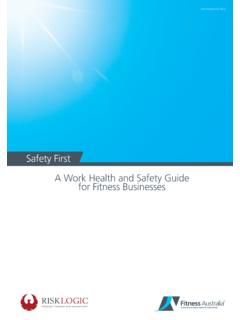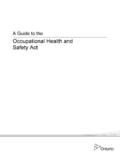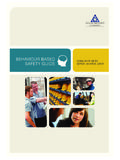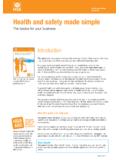Transcription of HEALTH & SAFETY - Department of Labour
1 HEALTH & SAFETYHEALT & SFTY S STA T F ST E T YTA LTE A LETA T A LFT TLE TY S A HEALT EAT&ASFY HEALT A&SFY HEALTH & SAFETYin the workplaceHEALTH & SAFETYIN THE WORKPLACEIN THE WORKPLACEHEALTH & SAFETYBe safe at workHEALTH & SAFETYIN THE WORKPLACEThis guide was written in the interest of the HEALTH and safetyof workers in South Africa. It is intended to explain the Act insimple terms to all the role players in the South Africanoccupational HEALTH and SAFETY & SAFETYIN THE WORKPLACEIN THE WORKPLACEHEALTH & SAFETY3 THE ROLE OF THE OCCUPATIONAL HEALTH AND SAFETY (OHS) INSPECTORS The role of the occupational HEALTH and SAFETY (OHS) inspectors of the Department of Labour is explained.
2 The duties and rights of workers, as extended to them in the Act, are set out. The roles and responsibilities of employers, manufacturers, designers, importers, suppliers and sellers, in ensuring the HEALTH and SAFETY of workers are highlighted. And finally, the functions of HEALTH and SAFETY representatives and committees are chief executive officer shall as far as is reasonably practicable ensure that the duties of his/her employer as contemplated in this Act, are properly Occupational HEALTH and SAFETY Act, 1993, requires the employer to bring about and maintain, as far as reasonably practicable, a work environment that is safe and without risk to the HEALTH of the workers.
3 This means that the employer must ensure that the workplace is free of hazardous substances, such as benzene, chlorine and micro organisms, articles, equipment, processes, etc. that may cause injury, damage or disease. Where this is not possible, the employer must inform workers of these dangers, how they may be prevented, and how to work safely, and provide other protective measures for a safe , it is not expected of the employer to take sole responsibility for HEALTH and SAFETY . The Act is based on the principle that dangers in the workplace must be addressed by communication and cooperation between the workers and the employer.
4 The workers and the employer must share the responsibility for HEALTH and SAFETY in the workplace. Both parties must pro-actively identify dangers and develop control measures to make the workplace safe. In this way, the employer and the workers are involved in a system where HEALTH and SAFETY representatives may inspect the workplace regularly and then report to a HEALTH and SAFETY committee, who in turn may submit recommendations to the employer. To ensure that this system works, every worker must know his or her rights and duties as contained in the Act. ACT AND REGULATIONSThe Act, known as the Occupational HEALTH and SAFETY Act, 1993 (Act 85, 1993) consists of 50 sections approved by Parliament.
5 The purpose of the Act is to provide for the HEALTH and SAFETY of people at work or in connection with the use of plant and machinery. It further provides for the protection of people other than people at work from hazards arising out of or in connection with the activities of people at Regulations, on published in terms of the Act from time to time by the Department of Act and Regulations can be purchased from the Government Printer in Gazette format or bound format from various OF LABOURC hief Directorate of Occupational HEALTH and SafetyThe Occupational HEALTH and SAFETY Act is administered by the Inspections and Enforcement Services Branch: Occupational HEALTH and SAFETY of the Department of Labour .
6 In order to ensure the HEALTH and SAFETY of workers, provincial offices have been established in all the provinces. To this end, occupational HEALTH and SAFETY inspectors from these provincial offices carry out inspections and investigations at workplaces. HEALTH & SAFETYIN THE WORKPLACEIN THE WORKPLACEHEALTH & SAFETY4 INSPECTIONSI nspections are usually planned on the basis of accident statistics, the presence of hazardous substances, such as the use of benzene in laundries, or the use of dangerous machinery in the workplace. Unplanned inspections, on the other hand, usually arise from requests or complaints by workers, employers, or members of the public.
7 These complaints or requests are treated of inspectorsIf an inspector finds dangerous or adverse conditions at the workplace, he or she may set requirements to the employer in the following ways:Prohibition noticeIn the case of threatening danger, an inspector may prohibit a particular action, process, or the use of a machine or equipment, by means of a prohibition notice. No person may disregard the contents of such a notice and compliance must take place with immediate noticeIf a provision of a regulation is contravened, the inspector may serve a contravention notice on the workers or the employer.
8 A contravention of the Act can result in immediate prosecution, but in the case of a contravention of a regulation, the employer may be given the opportunity to correct the contravention within a time limit specified in the notice which is usually 60 noticeWhere the HEALTH and SAFETY measures which the employer has instituted, do not satisfactorily protect the HEALTH and SAFETY of the workers, the inspector may require the employer to bring about more effective measures. A direction notice which prescribes the corrective measures is then served on the POWERSTo enable the inspector to carry out his or her duties, he or she may enter any workplace or premises where machinery or hazardous substances are being used and question or serve a summons on people to appear before him or her.
9 The inspector may request that any documents be submitted to him or her, investigate and make copies of the documents, and demand an explanation about any entries in such documents. The inspector may also inspect any condition or article and take samples of it, and seize any article that may serve as : The above mentioned powers of inspectors are not absolute. Any person who disagrees with any decision taken by an inspector, may appeal against that decision by writing to the: Chief InspectorOccupational HEALTH and SafetyDepartment of LabourPrivate Bag X117 Pretoria, 0001 HEALTH & SAFETYIN THE WORKPLACEIN THE WORKPLACEHEALTH & SAFETY5 GENERAL DUTIES OF EMPLOYERS TOWARDS WORKERSWhat must the employer do to ensure that the work environment is safe and without risk to the HEALTH of his or her workers?
10 The employer must provide and maintain all the equipment that is necessary to do the work, and all the systems according to which work must be done, in a condition that will not affect the HEALTH and SAFETY of workers. Before personal protective equipment may be used, the employer must first try to remove or reduce any danger to the HEALTH and SAFETY of his workers. Only when this is not practicable, should personal protective equipment be used. The employer must take measures to protect his or her workers HEALTH and SAFETY against hazards that may result from the production, processing, use, handling, storage or transportation of articles or substances, in other words, anything that workers may come into contact with at ensure that these duties are complied with, the employer must.

